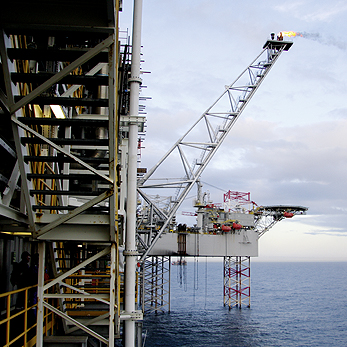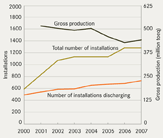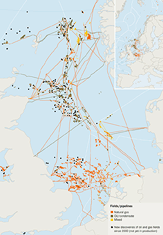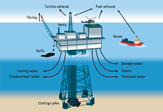What are the problems?
Pressures are greatest in the North Sea and expected to increase in the Arctic
The total amount of oil and gas produced within the OSPAR area has decreased by about 14% since 2001 to around 442 million tonnes of oil equivalents (toeq) in 2007, while the number of offshore installations has increased Figure 7.1. This indicates a trend towards the development of smaller fields. In 2007, around 60% of all operational installations reported air emissions and discharges to the sea as a result of oil and gas extraction.
A network of pipelines connects the oil and gas fields with the onshore distribution network Figure 7.2. The OSPAR area has more than 50 000 km of pipelines transporting oil and gas products from around 1300 installations.
The major offshore oil and gas developments within the OSPAR area are in the North Sea and Norwegian Sea; oil and gas in the northern North Sea and Norwegian Sea and mostly gas in the southern North Sea. Some production also takes place in the Irish Sea and Celtic Sea (gas only), the Bay of Biscay, the Gulf of Cadiz (gas only), and the Barents Sea Table 7.1. There is exploration for oil and gas in Region V, but as yet no production.
Environmental pressures from offshore oil and gas operations are greatest in Region II. However, oil and gas production has peaked in the North Sea and is now declining. For other parts of the OSPAR area, such as the Barents Sea, production is expected to increase. This is due to rising global demand and increased access to Arctic resources as sea ice retreats following the rise in global temperature. Some large projects are already underway, for example, the development of the Shtokman field in the Russian Barents Sea. A significant proportion of the world’s known oil and gas reserves are in the Arctic, with offshore areas of Greenland, the Faroe Islands, Iceland, northern Norway and Arctic Russia of particular interest. Increased production in Region I will bring an increase in environmental pressure. Marine ecosystems in the Arctic are considered to be particularly sensitive to impacts from offshore activities and effective management of oil spills and other impacts is important.
Different pressures on the marine environment
Routine operation of production platforms leads to the release of oil, chemicals and naturally occurring radioactive materials to the sea, especially through discharges of produced water and partly from drill cuttings Figure 7.3. Accidental oil spills can arise from different sources during operation.
The main source of oil discharge from routine production is produced water. This is the water that comes from the reservoir along with the oil. Produced water contains hazardous substances occurring naturally in the reservoir, such as heavy metals, aromatic hydrocarbons, alkyl phenols and radionuclides. Produced water also contains residues of chemicals used in the production process, including corrosion inhibitors and demulsifiers (chemicals that increase the separation of oil from water).
Drilling requires the use of fluids that may contain a range of chemicals. These chemicals may be water-based or based on organic-phase fluids (e.g. lighter oil fractions and synthetic fluids). Drilling fluids are generally recycled and are only disposed of once spent, but a small amount binds to rock fragments (cuttings) and is disposed of with the rest of the solid material removed from drilled rock. These cuttings can accumulate in piles at drilling sites. Old cuttings piles may contain oil (drilling fluids used to be mainly oil-based) and other contaminants and these are released into the sea over time. This is especially the case if these old cuttings piles get physically disturbed, for example by work around platforms or trawling. At some sites, cuttings are re-injected into the seabed to reduce their environmental impact, but there is some concern that this contaminated material could break through to the seabed.
Other pressures from oil and gas activities include emissions of volatile organic compounds, methane, sulphur dioxide, nitrogen oxides and carbon dioxide to the atmosphere. Chemicals can leak, for example, from pipeline valves and leach from coatings and anodes of pipelines and subsea structures. The seabed is physically disturbed when pipelines, cables, subsea structures and platforms are installed. Construction of offshore installations, drilling and seismic surveys during exploration are also sources of underwater noise Chapter 9. Carbon dioxide storage in sub-seabed geological formations such as abandoned oil and gas wells is an emerging offshore activity and will for example involve drilling of injection wells and placement of offshore installations Chapter 3.




